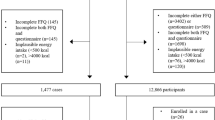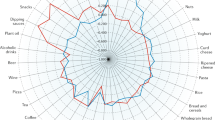Abstract
Objective:
To identify combinations of food groups that explain as much variation in absolute intakes of 23 key nutrients and food components as possible within the country-specific populations of the European Prospective Investigation into Cancer and Nutrition (EPIC).
Subjects/Methods:
The analysis covered single 24-h dietary recalls (24-HDR) from 36 034 subjects (13 025 men and 23 009 women), aged 35–74 years, from all 10 countries participating in the EPIC study. In a set of 39 food groups, reduced rank regression (RRR) was used to identify those combinations (RRR factors) that explain the largest proportion of variation in intake of 23 key nutrients and food components, namely, proteins, saturated fatty acids, monounsaturated fatty acids, polyunsaturated fatty acids, cholesterol, sugars (sum of mono- and disaccharides), starch, fibre, alcohol, calcium, iron, potassium, phosphorus, magnesium, vitamin D, β-carotene, retinol and vitamins E, B1, B2, B6, B12 and C (RRR responses). Analyses were performed at the country level and for all countries combined.
Results:
In the country-specific analyses, the first RRR factor explained a considerable proportion of the total nutrient intake variation in all 10 countries (27.4–37.1%). The subsequent RRR factors were much less important in explaining the variation (⩽6%). Strong similarities were observed for the first country-specific RRR factor between the individual countries, largely characterized by consumption of bread, vegetable oils, red meat, milk, cheese, potatoes, margarine and processed meat. The highest explained variation was seen for protein, potassium, phosphorus and magnesium (50–70%), whereas sugars, β-carotene, retinol and alcohol were only marginally explained (⩽5%). The explained proportion of the other nutrients ranged between these extremes.
Conclusions:
A combination of food groups was identified that explained a considerable proportion of the nutrient intake variation in 24-HDRs in every country-specific EPIC population in a similar manner. This indicates that, despite the large variability in food and nutrient intakes reported in the EPIC, the variance of intake of important nutrients is explained, to a large extent, by similar food group combinations across countries.
This is a preview of subscription content, access via your institution
Access options
Subscribe to this journal
Receive 12 print issues and online access
$259.00 per year
only $21.58 per issue
Buy this article
- Purchase on Springer Link
- Instant access to full article PDF
Prices may be subject to local taxes which are calculated during checkout


Similar content being viewed by others
References
Bingham S, Riboli E (2004). Diet and cancer—the European Prospective Investigation into Cancer and Nutrition. Nat Rev Cancer 4, 206–215.
Brustad M, Skeie G, Braaten T, Slimani N, Lund E (2003). Comparison of telephone vs face-to-face interviews in the assessment of dietary intake by the 24 h recall EPIC SOFT program—the Norwegian calibration study. Eur J Clin Nutr 57, 107–113.
Cust AE, Skilton MR, van Bakel MME, Halkjær J, Olsen A, Agnoli C et al. (2009). Total dietary carbohydrate, sugar, starch and fibre intakes in the European Prospective Investigation into Cancer and Nutrition. Eur J Clin Nutr 63 (Suppl 4), S37–S60.
Halkjær J, Olsen A, Bjerregaard LJ, Deharveng G, Tjønneland A, Welch AA et al. (2009). Intake of total, animal and plant proteins, and their food sources in 10 countries in the European Prospective Investigation into Cancer and Nutrition. Eur J Clin Nutr 63 (Suppl 4), S16–S36.
Hatcher L (1994). A Step-by-Step Approach to Using the SAS system for Factor Analysis and Structural Equation Modeling. SAS Institute Inc: Cary, North Carolina.
Hoffmann K, Schulze MB, Schienkiewitz A, Nothlings U, Boeing H (2004). Application of a new statistical method to derive dietary patterns in nutritional epidemiology. Am J Epidemiol 159, 935–944.
Hu FB (2002). Dietary pattern analysis: a new direction in nutritional epidemiology. Curr Opin Lipidol 13, 3–9.
Jenab M, Salvini S, van Gils CH, Brustad M, Shakya-Shrestha S, Buijsse B et al. (2009). Dietary intakes of retinol, β-carotene, vitamin D and vitamin E in the European Prospective Investigation into Cancer and Nutrition cohort. Eur J Clin Nutr 63 (Suppl 4), S150–S178.
Linseisen J, Welch AA, Ocké M, Amiano P, Agnoli C, Ferrari P (2009). Dietary fat intake in the European Prospective Investigation into Cancer and Nutrition: results from the 24-hour dietary recalls. Eur J Clin Nutr 63 (Suppl 4), S61–S80.
Newby PK, Tucker KL (2004). Empirically derived eating patterns using factor or cluster analysis: a review. Nutr Rev 62, 177–203.
Olsen A, Halkjær J, van Gils CH, Buijsse B, Verhagen H, Jenab M et al. (2009). Dietary intake of the water-soluble vitamins B1, B2, B6, B12 and C in 10 countries in the European Prospective Investigation into Cancer and Nutrition. Eur J Clin Nutr 63 (Suppl 4), S122–S149.
Riboli E, Hunt KJ, Slimani N, Ferrari P, Norat T, Fahey M et al. (2002). European Prospective Investigation into Cancer and Nutrition (EPIC): study populations and data collection. Public Health Nutr 5 (Suppl), S1113–S1124.
Schulze MB, Hoffmann K, Kroke A, Boeing H (2003). An approach to construct simplified measures of dietary patterns from exploratory factor analysis. Br J Nutr 89, 409–419.
Sieri S, Krogh V, Saieva C, Grobbee DE, Bergmann M, Rohrmann S et al. (2009). Alcohol consumption patterns; diet and body weight in 10 European countries. Eur J Clin Nutr 63 (Suppl 4), S81–S100.
Skeie G, Braaten T, Hjartåker A, Lentjes M, Amiano P, Jakszyn P et al. (2009). Use of dietary supplements in the European Prospective Investigation into Cancer and Nutrition calibration study. Eur J Clin Nutr 63 (Suppl 4), S226–S238.
Slimani N, Deharveng G, Charrondiere RU, van Kappel AL, Ocke MC, Welch A et al. (1999). Structure of the standardized computerized 24-h diet recall interview used as reference method in the 22 centers participating in the EPIC project. European Prospective Investigation into Cancer and Nutrition. Comput Methods Programs Biomed 58, 251–266.
Slimani N, Deharveng G, Unwin I, Southgate DA, Vignat J, Skeie G et al. (2007). The EPIC nutrient database project (ENDB): a first attempt to standardize nutrient databases across the 10 European countries participating in the EPIC study. Eur J Clin Nutr 61, 1037–1056.
Slimani N, Fahey M, Welch AA, Wirfalt E, Stripp C, Bergstrom E et al. (2002a). Diversity of dietary patterns observed in the European Prospective Investigation into Cancer and Nutrition (EPIC) project. Public Health Nutr 5 (Suppl), S1311–S1328.
Slimani N, Ferrari P, Ocke M, Welch A, Boeing H, Liere M et al. (2000). Standardization of the 24-hour diet recall calibration method used in the European Prospective Investigation into Cancer and Nutrition (EPIC): general concepts and preliminary results. Eur J Clin Nutr 54, 900–917.
Slimani N, Kaaks R, Ferrari P, Casagrande C, Clavel-Chapelon F, Lotze G et al. (2002b). European Prospective Investigation into Cancer and Nutrition (EPIC) calibration study: rationale, design and population characteristics. Public Health Nutr 5 (Suppl), S1125–S1145.
Welch AA, Fransen H, Jenab M, Boutron-Ruault MC, Tumino R, Agnoli C et al. (2009). Variation in intakes of calcium, phosphorus, magnesium, iron and potassium in 10 countries in the European Prospective Investigation into Cancer and Nutrition study. Eur J Clin Nutr 63 (Suppl 4), S101–S121.
Acknowledgements
The work described in the paper was carried out with the financial support of the European Commission: Public Health and Consumer Protection Directorate 1993–2004; Research Directorate-General 2005; Ligue contre le Cancer (France); Société 3M (France); Mutuelle Générale de l’Education Nationale; Institut National de la Santé et de la Recherche Médicale (INSERM); Institut Gustave Roussy; German Cancer Aid; German Cancer Research Center; German Federal Ministry of Education and Research; Danish Cancer Society; Health Research Fund (FIS) of the Spanish Ministry of Health; Spanish Regional Governments of Andalucía, Asturias, Basque Country, Murcia and Navarra and the Catalan Institute of Oncology; and ISCIII RETIC (RD06/0020), Spain; Cancer Research UK; Medical Research Council, UK; the Stroke Association, UK; British Heart Foundation; Department of Health, UK; Food Standards Agency, UK; the Wellcome Trust, UK; Greek Ministry of Health; Hellenic Health Foundation; Italian Association for Research on Cancer; Italian National Research Council, Regione Sicilia (Sicilian government); Associazione Iblea per la Ricerca Epidemiologica—ONLUS (Hyblean association for epidemiological research, NPO); Dutch Ministry of Health, Welfare and Sport; Dutch Prevention Funds; LK Research Funds; Dutch ZON (Zorg Onderzoek Nederland); World Cancer Research Fund (WCRF); Swedish Cancer Society; Swedish Research Council; Regional Government of Skane and the County Council of Vasterbotten, Sweden; Norwegian Cancer Society; the Norwegian Research Council and the Norwegian Foundation for Health and Rehabilitation. We thank Sarah Somerville, Nicole Suty and Karima Abdedayem for their assistance with editing, and Kimberley Bouckaert and Heinz Freisling for their technical assistance.
Author information
Authors and Affiliations
Corresponding author
Additional information
Guarantor: J Kröger.
Contributors: JK carried out the statistical analyses, prepared the tables and figures, and wrote the paper, taking into account comments from all co-authors. NS was the overall coordinator of this project and of the EPIC Nutrient DataBase (ENDB) project. JK, PF, MJ, CB, MT, HBB-d-M, MTF, VB, MS, EW, HB, KH and MBS were members of the writing group and gave input on the statistical analyses, drafting of the manuscript and interpretation of results. The other co-authors were local EPIC collaborators who participated in the collection of dietary and other data, and in the ENDB project. ER is the overall coordinator of the EPIC study. All co-authors provided comments and suggestions on the manuscript and approved the final version.
Rights and permissions
About this article
Cite this article
Kröger, J., Ferrari, P., Jenab, M. et al. Specific food group combinations explaining the variation in intakes of nutrients and other important food components in the European Prospective Investigation into Cancer and Nutrition: an application of the reduced rank regression method. Eur J Clin Nutr 63 (Suppl 4), S263–S274 (2009). https://doi.org/10.1038/ejcn.2009.85
Published:
Issue Date:
DOI: https://doi.org/10.1038/ejcn.2009.85
Keywords
This article is cited by
-
Dietary pattern associated with selenoprotein P and MRI-derived body fat volumes, liver signal intensity, and metabolic disorders
European Journal of Nutrition (2019)
-
Breakfast quality and cardiometabolic risk profiles in an upper middle-aged German population
European Journal of Clinical Nutrition (2017)
-
An application of partial least squares for identifying dietary patterns in bone health
Archives of Osteoporosis (2017)
-
Stability of dietary patterns assessed with reduced rank regression; the Zutphen Elderly Study
Nutrition Journal (2014)
-
Dietary Lipid Intake only Partially Influences Variance in Serum Phospholipid Fatty Acid Composition in Adolescents: Impact of Other Dietary Factors
Lipids (2014)



